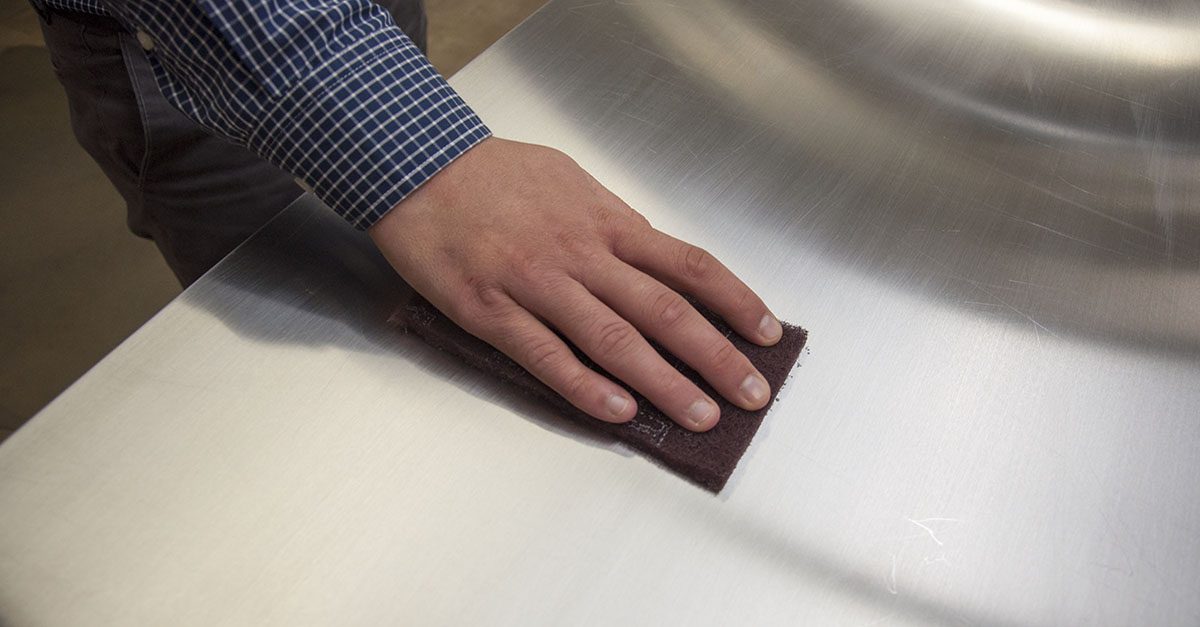
 Correct Tools & Cleansers
Correct Tools & Cleansers
Help prevent your stainless steel from corroding by cleaning it
with the recommended tools and cleansers
Tools: Use soft cloths and plastic scouring pads. Stainless steel scouring pads may only be
used in the direction of / parallel to the visible lines. See diagram below for visual.
Cleansers: Use Alkaline, Alkaline Chlorinated, or non-chloride containing cleansers.
Please refer to the ingredient label of your cleanser to determine if it contains chloride content.
 Incorrect Tools & Cleansers
Incorrect Tools & Cleansers
Use of these products will void warranty!
Tools: Do not use wire brushes or metal scrapers. Also do not use steel
scouring pads against the designated polish lines.
Cleansers: Do not use abrasive cleaners containing chlorides or quaternary salts.
Always Clean & Polish With the Grain of the Stainless Steel

8 Tips to Keep Your Stainless Steel Clean and Corrosion Free
1. Utilize the proper tools.
2. Wipe with the grain of the stainless steel.
3. Utilize alkaline, alkaline chlorinated, or non-chloride containing cleansers.
4. Soften hard water with filters to reduce mineral deposits.
5. Clean your equipment frequently to prevent food particles from causing pits and cracks.
6. If a chlorinated cleanser is used, rinse and dry immediately.
7. Absolutely, under any circumstances never use hydrochloric acid (muriatic acid) on stainless steel.
8. Periodically restore or passivate your stainless steel.
9. Thoroughly rinse any surfaces exposed to mild steel products after cleaning - cast iron skillets or pots, tools, packaging materials or utensils.
BK-SS-CAREKIT Contents Instructions
Bar Keepers Friend is used for general daily cleansing of your stainless steel product.
Use a liberal amount on a sponge or scrubbing pad designed for stainless steel cleaning
(red cleansing pad included) to clean your sink and rinse thoroughly afterward.
The red cleansing pad may be used in conjunction with the Bar Keepers Friend for tougher stains and contaminant removal.
Never use steel wool to clean stainless steel. Always rub with the grain of the stainless when using this pad for best results.
Stainless Steel Polish (Sheila Shine) is used on your clean stainless to give it a fresh shining finish
and help protect it from anything that may damage the stainless material.
Cleaning Guide Chart

Properties And Chemical Reactions Of Stainless Steel
300 series stainless steel contains iron, chromium, and nickel. 400 series stainless steel contains iron and chromium. Since both series contain 70-80% iron, they are both capable of rusting under certain conditions. With a 12-30% chromium are passive towards corrosion. This means an invisible film covers the steel’s surface, creating a barrier against corrosion, causing the metal to be stainless, This film is only millionths of an inch thick, so if the film is broken down or scratched, your equipment will begin to show signs of corrosion. The goal is to keep this film intact by applying proper maintenance and cleaning procedures to stainless steel to obtain maximum longevity of your equipment.What Causes Corrosion?
Corrosion can manifest itself on your stainless steel equipment if the passive film has been broken down. The initial signs of the process begins with tiny pits and cracks on the surface of the steel, unable to be seen with the naked eye. Only with a magnifying glass or a microscope, can these “symptoms” be seen. Over time, these pits and cracks will continue to increase in size and depth, resulting in the topical red-orange rust visible to the unaided eye.
What Causes The Passive Film Layer to Deteriorate?
1. Steel pads, wire brushes, or anything abrasive that will scratch the surface.2. Mineral deposits left over from hard water.
3. Chlorides that are found in household cleansers, water, food particles (that are left behind after food preparation), and table salt.

